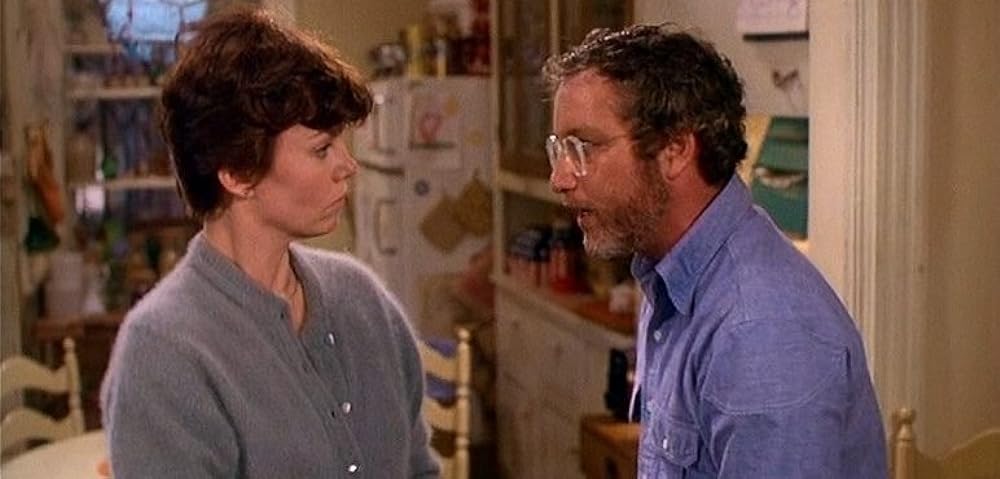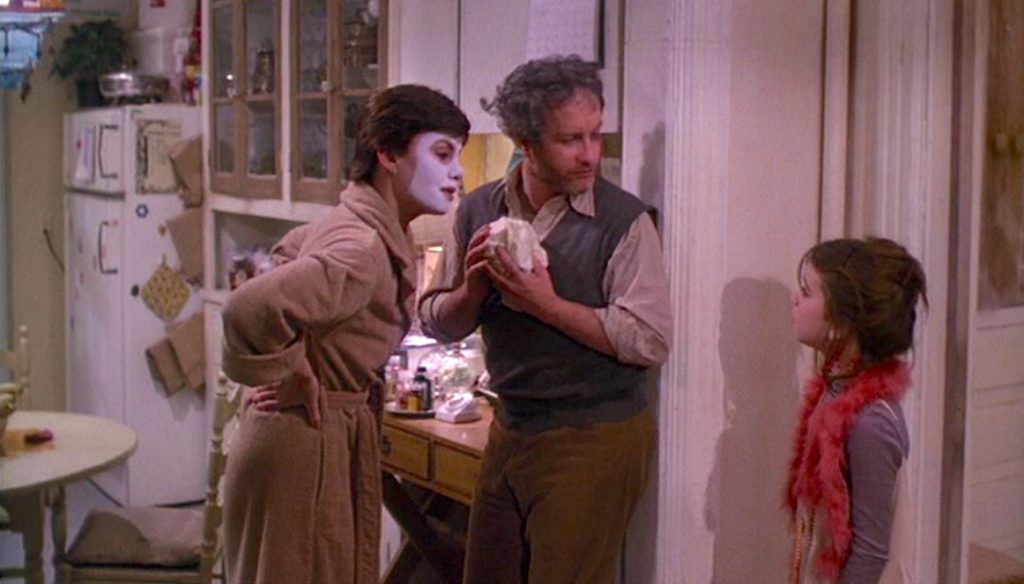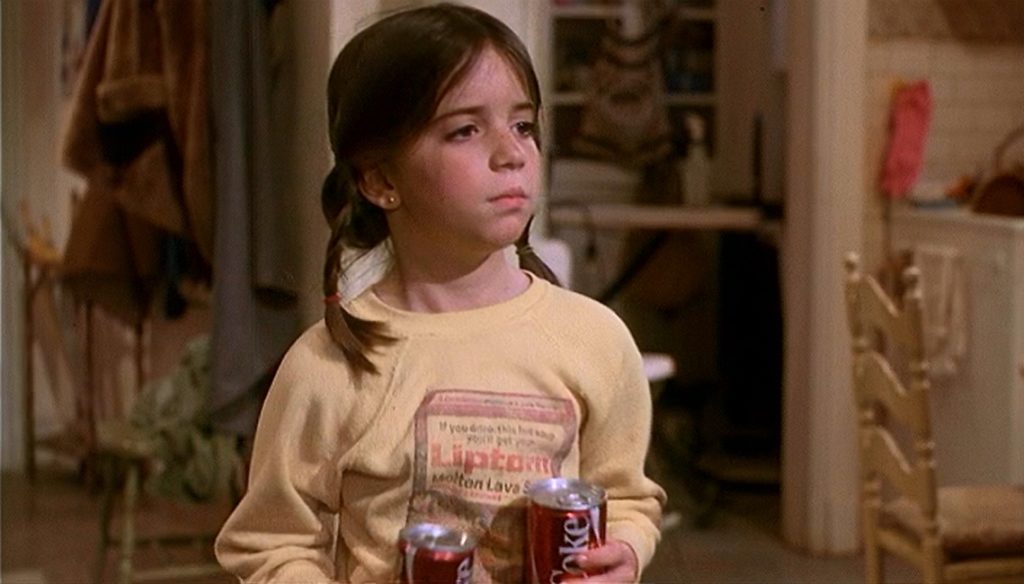| Penny Folger |

Marsha Mason and Ricard Dreyfuss: struggling entertainers & reluctant roommates
The Goodbye Girl plays at the Trylon Cinema from Friday, May 10th, through Sunday, May 13th. Visit trylon.org for tickets and more information.
The Goodbye Girl played on daytime television with some regularity while I was growing up. Either that or I just caught it the one time and it left an enduring impression. It’s hard to say which it was when scanning back through my memories of childhood, but I remember Richard Dreyfuss playing guitar, trying to soothe 10-year-old Quinn Cummings’ upset stomach which, in turn, soothed me as a viewer on a summer weekday afternoon while eating chicken soup.
This was way back in the era when you stumbled upon something you’d never heard of or would never have known about otherwise, but it appeared on your television so that is what you watched. Oftentimes, it was a movie or TV show from another era.
The Goodbye Girl begins with a dilemma: a man relocating from Chicago has just sublet an apartment (paying 3 months rent upfront) in the New York City of the 1970s, where things may have been cheaper but were also rougher. The catch: a 33-year-old ex-dancer and her extremely precocious 10-year-old daughter are already living in the apartment, having just been walked out on by the woman’s actor boyfriend who had the foresight to immediately sublet it to someone else without telling them. Also, it’s raining, late at night, and this man has nowhere else to go. But worst of all, he’s an actor. It’s also an actor who has just walked out on this little family—the proverbial door still swinging behind him in his wake. In this movie, “actor” is a dirty word, like the kind that the 10-year-old Cummings can be heard spouting for comedic effect.
As Marsha Mason’s character Paula McFadden, the ex-dancer, puts it, “You grow up fast in this apartment.”

A trio of Oscar nominees fight over an apartment.
Written by acclaimed playwright Neil Simon, the initial script for this film began where The Goodbye Girl actually ends. Entitled Bogart Slept Here, it was based on what Mike Nichols saw Dustin Hoffman go through when Hoffman was catapulted from a life of doing off-Broadway in New York City to overnight Hollywood movie stardom. (Ironically it was Nichols who discovered Hoffman off-Broadway and put him in the movie The Graduate, which was largely responsible for this.) Or, as Dreyfuss would later summarize, the original story was based on “what happened to Dustin Hoffman when he became a star and how it wrecked his life for a while.”1
Both Mike Nichols and Robert De Niro were originally attached to the project but De Niro was fired—it would have been his follow-up to Taxi Driver, which seems an odd choice—and Nichols left shortly afterward. Watching the movie that resulted while trying to imagine De Niro instead of Dreyfuss in the lead is in fact difficult, and you begin to understand why his replacement was necessary. Dreyfuss here is flamboyant, hyperverbal and kinetic. As Simon put it, “It’s not that De Niro is not funny, but his humor comes mostly from his nuances: a bemused expression on his face or the way he would look at a character, smile and then look up at the ceiling.”2 With this new vacancy, Dreyfuss was runner-up, but after doing a reading of Simon’s script four months later, something about the story seemed amiss.
Joked Dreyfuss about the original story’s protagonist, “If this man had his daughter kidnapped by terrorists, there would be no sympathy for him because he was a movie star.”3 In short, the problems of an extremely successful person did not seem like they would be immediately relatable to a general audience. Though I see what Simon and Nichols had originally been going for: the fish-out-of-water awkwardness Hoffman portrayed so beautifully in The Graduate being suddenly surrounded by paparazzi, limousines, and “yes-men.”
In the end, said Dreyfuss, “Nobody cares.”4
Seeing the problem, Simon completed what was essentially a prequel to his original script in three weeks’ time—playing upon the idea that people were more sympathetic when in peril before they became wildly successful. I still think there’s a place for a portrayal of the darker side of fame to be interesting: a phenomenon which has been so apparent when watching people like Britney Spears or the life of so many fallen child stars who go on to rob banks or die in prison from heroin addictions or what have you. But perhaps America was not ready to embrace this in 1977.
What’s also interesting is that this wisecracking romantic comedy is what Dreyfuss chose to follow up the twin juggernauts of Jaws and Close Encounters of the Third Kind with, although admittedly, he was initially hesitant to take the role at all. The phenomenon that was Jaws and the subsequent birth of the blockbuster cannot be overstated, though it’s difficult to imagine what Dreyfuss could have followed these record-breaking Spielberg films up with that would have been in the same vein. Close Encounters was the most successful Columbia Pictures movie of its day. Certainly, Dreyfuss as an everyman wasn’t going to go on to play Indiana Jones. Instead, Dreyfuss in The Goodbye Girl is charismatically unhinged, and he won an Oscar for it. Cummings and Mason both received nominations in turn.
Cummings is brilliant here, but she gets a lot of the film’s one-liners and delivers them with a self-possession and quick-wittedness that for a ten-year-old is almost eerie. As Mason tells her during the film’s opening, “You were never four and a half. You were born 26.” Listening to Cummings in this movie, this does not feel like that much of an exaggeration.

Scene stealer.
Dreyfuss has arguably a lot more to work with than Mason, particularly comedically, as in the terrible rendition of Richard III he is asked to play in which supplies some of the film’s comedy. Mason’s Paula, in order to serve the plot, is in more of a victim role—a type of role that is not really as interesting to watch, however realistic such things might be. Her challenge in the arc of the story seems to be to overcome the betrayal she experiences in the film’s first five minutes and learn how to trust again. Totally valid but not as entertaining, despite the fact that Simon, who was her husband at the time, wrote the part with her in mind.
While Dreyfuss gets to play the eccentric and Cummings is funny beyond her years, if this film is a romantic comedy, Mason simply doesn’t get as much of the funny. (Interestingly Cummings is a stand-in for the quirky but supportive best friend character you might see in a more run-of-the-mill romantic comedy not written by a multi-award-winning playwright.) Not to belittle Mason’s contributions. After all, someone has to be the straight man. With three frenetic tornadoes at the helm, the audience might have just wound up dizzy and unmoored.
Mason spends a lot of the film reacting to her unfortunate life circumstances and the perceived fact that she is “over the hill” at 33. In all fairness, being a professional dancer probably does in fact have a shorter shelf life. Despite the part allegedly being written for her by her then-husband the movie doesn’t feel in the end as much like it’s her vehicle as much as it feels like it’s Dreyfuss’s. This film in fact functions primarily as a vehicle for Dreyfuss. (And perhaps Simon.)
While never quite matching the multi-blockbuster success he enjoyed in the latter half of the 1970s, Dreyfuss would nevertheless go on to enjoy a long career, though he’s spoken about how winning an Oscar for The Goodbye Girl by the age of 30 unmoored him. Said Dreyfuss in 2021, “I would have preferred to have won it now. It took away the carrot. It took away what I was hunting for, and I was much more comfortable on the hunt.”5 Ironically his catapult to stardom and acclaim and subsequent disillusionment mirrored the story of Hoffman which was the seed of this film in the first place.
Cummings dropped out of acting by the age of 24, realizing she simply no longer enjoyed it, and continues to use her wit in the service of her writing career. She is now a published author with a comedy podcast entitled “Quinn Cummings Gives Bad Advice” and making funny quips publicly seems to have become something of a lifelong career, beyond her memorable stint doing it in The Goodbye Girl.
Mason moved out of Hollywood in the late ‘80s—she and Simon divorced in 1983 after 10 years of marriage, leaving on good terms and even working together again on stage with Dreyfuss. She went on to become an organic farmer in New Mexico and a race car driver, in addition to continuing to appear in television and the occasional film.
All this backstory aside, what is so endearing about this film that makes rewatches of it such a comfort instead of a chore? Is it the draw of New York in the 1970s, a time when American films seemed more thoughtful and were made more with adults in mind? Aside from its snappy Simon-penned repartee, it would seem to be the chemistry of its three leads, and the fact that it’s just nice to spend time in their company. There is something about Dreyfuss playing his guitar soothingly as the trio of them gather on a bed, that seems to convey love, and the sweet charm of this still radiates from the screen a mere 47 years later. The Academy of Motion Picture Arts & Sciences seems to have agreed.
References
1 Richard Dreyfuss, interview by Ben Mankiewicz, TCM Classic Film Festival, Egyptian Theater (April 12, 2014) Hollywood, CA.
2 “Articles on The Goodbye Girl.” tcm.com. Wikimedia Foundation. http://en.wikipedia.org/wiki/The_Goodbye_Girl#cite_note-gog-4.
3 Richard Dreyfuss, interview by Ben Mankiewicz, TCM Classic Film Festival 2021.
4 Richard Dreyfuss, interview by Ben Mankiewicz, TCM Classic Film Festival 2021.
5 Richard Dreyfuss, interview by Ben Mankiewicz, TCM Classic Film Festival 2021.
Edited by Olga Tchepikova-Treon
